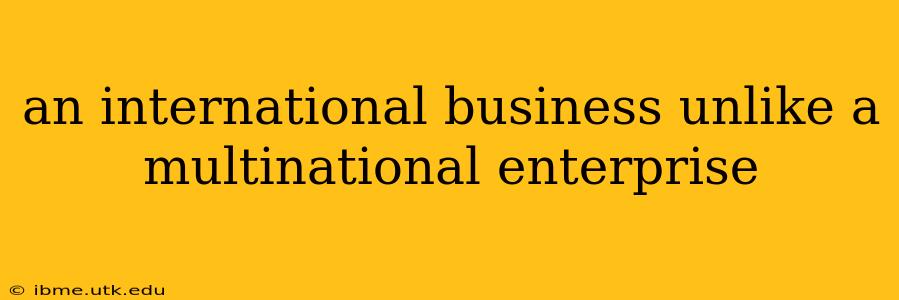The terms "international business" and "multinational enterprise" (MNE) are often used interchangeably, leading to confusion. While related, they represent distinct organizational structures and operational strategies. Understanding these differences is crucial for businesses aiming for global expansion. This article delves into the key distinctions between an international business and an MNE, exploring their strategies, structures, and implications.
What is an International Business?
An international business is any company that engages in commercial activities across national borders. This can range from small businesses exporting goods to larger companies with international subsidiaries. The key differentiator is the limited scope of international operations. They might export, import, or have a few foreign offices, but their primary operations and management remain firmly rooted in their home country. They don't necessarily have a significant presence in multiple countries or a globally integrated structure.
What is a Multinational Enterprise (MNE)?
A multinational enterprise (MNE), also known as a multinational corporation (MNC), is a large company with significant operations in multiple countries. Unlike international businesses, MNEs are characterized by their decentralized structure. They often establish subsidiaries or branches in numerous countries, each operating with a degree of autonomy, but coordinated under a central parent company. They typically have a global supply chain, marketing strategies tailored to local markets, and a considerable level of foreign direct investment (FDI).
Key Differences Between International Businesses and MNEs
Several key aspects distinguish international businesses from MNEs:
1. Scale and Scope of Operations:
- International Business: Relatively smaller scale; operations primarily focused in the home country with limited international activities.
- MNE: Large-scale operations; significant presence and investment in numerous countries; often boasts global brand recognition and influence.
2. Organizational Structure:
- International Business: Typically centralized management; decisions primarily made at the headquarters.
- MNE: Decentralized structure; substantial autonomy granted to foreign subsidiaries; global coordination through centralized strategies and decision-making on a broader scale.
3. Management and Control:
- International Business: Home country management retains tight control over international operations.
- MNE: Management is often distributed across multiple countries, with subsidiary managers having significant operational freedom within defined strategic parameters.
4. Degree of Integration:
- International Business: Limited integration of operations across borders.
- MNE: High degree of integration across global operations; often boasts synchronized supply chains, marketing, and R&D across various countries.
5. Market Responsiveness:
- International Business: May adapt products or services minimally for international markets.
- MNE: Highly responsive to local market needs and preferences; often develops products or services tailored to specific countries.
6. Investment and Resources:
- International Business: Lower levels of investment in foreign markets compared to MNEs.
- MNE: Substantial foreign direct investment (FDI) and resource allocation across various countries.
How to Choose the Right Model: International Business vs. MNE
The best model—international business or MNE—depends on several factors:
- Company size and resources: Smaller companies may find an international business model more appropriate, while larger companies with significant resources are better suited for the MNE model.
- Market opportunity: If the market opportunity is limited to a few countries, an international business model may suffice. A broader, global opportunity typically points to an MNE strategy.
- Risk tolerance: The MNE model involves higher levels of risk and investment but also offers greater potential returns.
- Strategic goals: Long-term global ambitions often require the more complex structure of an MNE.
Successfully Navigating the International Landscape
Regardless of the chosen model, understanding the complexities of international business is paramount. This includes understanding local laws and regulations, navigating cultural differences, managing foreign exchange risk, and coordinating global supply chains. Strategic partnerships, skillful adaptation to diverse markets, and robust risk management strategies are critical for success in the international arena.
By carefully considering these factors, businesses can choose the organizational structure and strategy best suited to their specific circumstances, maximizing their global potential while mitigating associated risks.
